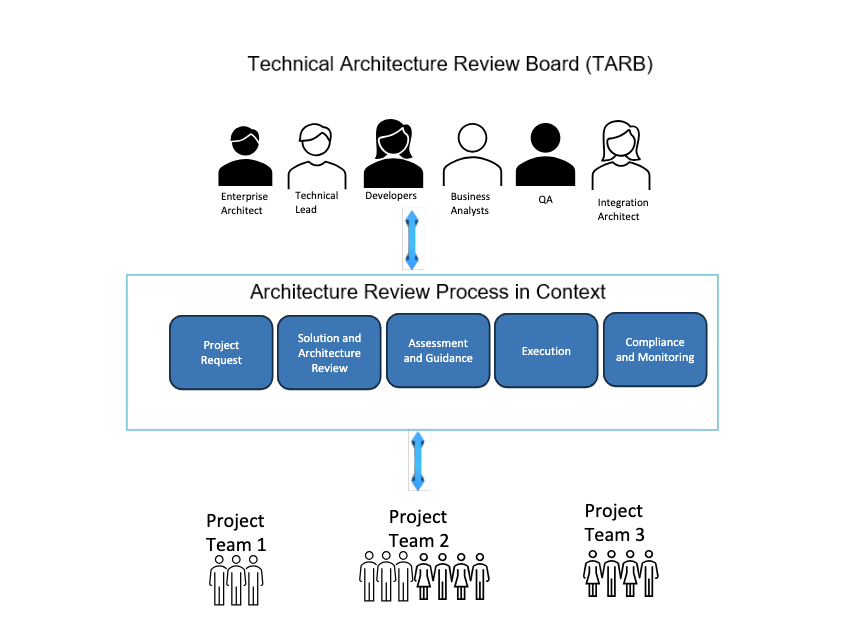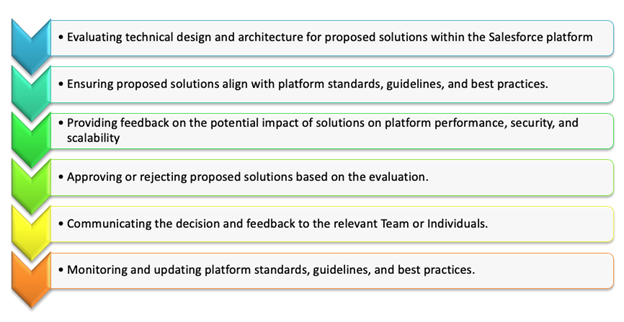How to Ensure Salesforce Technical Architecture Integrity and Stability

To elevate your Salesforce implementation and managed services to the next level, partnering with an SI who adheres to the highest possible standards is crucial. At RafterOne, our primary goal is to arm our clients with the most cutting-edge and innovative solutions on the Salesforce Platform. As a part of this commitment, we validate solution designs for our customers, which our TARB (Technical Architecture Review Board) oversees. This helps us ensure our customers receive the best solutions that meet their unique requirements.
What is TARB
The Salesforce Technical Architecture Review Board (TARB) is a governing body that operates within organizations that use the Salesforce platform. Its primary function is to review and approve proposed technical solutions to ensure they comply with the platform’s standards, guidelines, and best practices. The TARB evaluates solutions based on their potential impact on platform performance, security, scalability, and data architecture. The board provides feedback, makes recommendations, and approves or rejects solutions. The main objective of the TARB is to maintain the integrity and stability of the Salesforce platform while facilitating innovation and growth.
Below is the High-Level visual representation of RafterOne’s TARB way of working.

At RafterOne, our TARB governance body includes members with diverse backgrounds in software development, data analysis, engineering, security, and enterprise architecture. It enables a comprehensive evaluation of proposed architectural changes from multiple perspectives.
How TARB Works
Teams and individuals need to present their solution design documents, including High-Level Design (HLD) and Low-Level Design (LLD), to the Technical Architecture Review Board (TARB). During the meetings, open discussions allow a thorough evaluation and brainstorming of the proposed solutions. A sound decision-making framework is crucial for a Technical Architecture Review Board (TARB) to assess proposed solutions and make informed architectural decisions.
Here at RafterOne’s, the Salesforce Technical Architecture Review Board (TARB) is responsible for:

RafterOne’s Architects Responsibility
As architects, we are responsible for overseeing systems’ design and architecture. To ensure the success of our client projects, we hold regular meetings where we can discuss progress, identify potential issues, and brainstorm solutions. During these meetings, we also explore new technologies or ideas that may help improve our and client systems. Additionally, these meetings allow us to stay updated with the latest developments in the Salesforce ecosystem, learn from our peers, and discuss best practices. Ultimately, these meetings are crucial for ensuring our systems/projects are robust and reliable.
TARB Formation
At RafterOne, we believe that the Salesforce Technical Architecture Review Board (TARB) should consist of members from various roles, such as Enterprise Architects, Salesforce Architects, Functional/Solution Architects, Domain Architects, Technical Leads/Developers, Business Analysts, Integration Specialists, Quality Assurance (QA) Analysts, and representatives from the business or key stakeholders. Such diverse representation in the TARB would help ensure that all aspects of the Salesforce technical architecture are considered and evaluated thoroughly. It ensures that technical architecture decisions for Salesforce implementations are well-informed, collaborative, and aligned with business objectives, technical requirements, and industry best practices.
Leverage Collective Expertise with TARB
Forming a governance body consisting of individuals from diverse backgrounds possessing various knowledge and domain expertise can offer several advantages.
- Diverse Expertise: TARB comprises members with diverse backgrounds, experiences, and expertise, such as architecture, development, security, compliance, and business analysis. Their different perspectives allow TARB to comprehensively consider various aspects of Salesforce implementations and make well-informed decisions.
- Teamwork and Consensus: TARB fosters collaboration among members involved in Salesforce implementations by facilitating discussions, knowledge sharing, and feedback to build consensus around technical decisions. This approach ensures collective decision-making based on shared understanding and agreement.
- Broader Ownership: Board members from various departments, business units, and functional areas serve as advocates, promoting adherence to architectural guidelines and enhancing alignment between technical solutions and business objectives for improved Salesforce implementation success.
- Reduced Bias: TARB prevents biases by bringing together diverse members and experts to evaluate technical architecture proposals objectively. Decisions are based on merit, best practices, and relevant factors.
- Shared Responsibility: TARB encourages shared responsibility for technical architecture decisions. It fosters collaboration and collective ownership for Salesforce implementations, leading to better outcomes and higher satisfaction.
Adopt Next Level Technical Architecture Standards
As organizations look to optimize their Salesforce environments, RafterOne’s TARB exemplifies how structured oversight and dynamic collaboration can lead to superior outcomes and sustained growth in the digital world. The Technical Architecture Review Board’s thorough review processes and diverse expertise ensure that solutions are innovative and adhere to the highest standards of quality and efficiency. By leveraging collective wisdom and a collaborative approach, TARB steers projects toward success while aligning with business objectives and technical requirements.